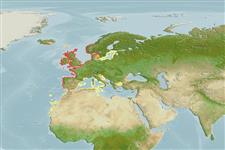Classification / Names
Common names from other countries
Main reference
Size / Weight / Age
Max length : 9.0 cm TL male/unsexed; (Ref. 6303); max. reported age: 3 years (Ref. 40230)
Length at first maturity
Lm ?, range 3 - ? cm
Environment
Marine; freshwater; brackish; demersal; amphidromous (Ref. 51243); depth range 0 - 12 m (Ref. 35388)
Climate / Range
Temperate; 8°C - 24°C (Ref. 4944), preferred ?; 64°N - 20°N, 19°W - 31°E
Distribution
Eastern Atlantic: Norway to Morocco, including Baltic Sea (to southern Portugal) (Ref. 4696) and western Mediterranean. Also in Mauritania and the Canary Islands.
Countries | FAO areas | Ecosystems | Occurrences | Introductions
Short description
Dorsal
spines
(total): 6 - 8;
Dorsal
soft rays
(total): 8-11;
Anal
spines: 1;
Anal
soft rays: 7 - 10;
Vertebrae: 30 - 32. This species is distinguished from other gobies in European freshwaters by the following characters: males with conspicuous dark proximal posterior spot on first dorsal; with cephalic lateral line canals; anterior oculoscapular canal extending to snout; branched rays in second dorsal 8-10.5; anal origin below simple of first branched ray of D2; total scales in midlateral series 39-52; completely scaled postdorsal body; caudal rounded (Ref. 59043). No scales in front of the first dorsal fin (Ref. 35388); body shape is terete, slightly depressed; eyes situated dorso-laterally; reduced swim bladders (Ref. 92840).
IUCN Red List Status (Ref. 115185)
Threat to humans
Harmless
Human uses
Fisheries: of no interest; aquarium: commercial
Tools
Special reports
Download XML
Internet sources
Estimates of some properties based on models
Phylogenetic diversity index
PD50 = 0.5002 many relatives (e.g. carps) 0.5 - 2.0 few relatives (e.g. lungfishes)
Trophic Level
3.3 ±0.3 se; Based on diet studies.
Resilience
Medium, minimum population doubling time 1.4 - 4.4 years (K=0.29; tm=0.8; tmax=2.6; Assuming fec < 10,000)
Vulnerability
Low to moderate vulnerability (33 of 100)
Price category
